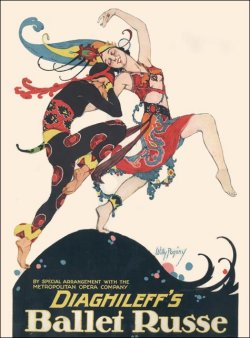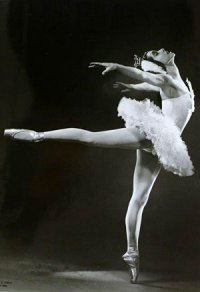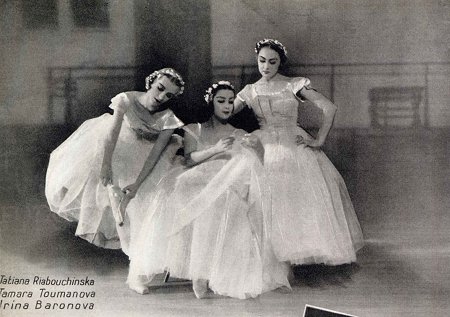
Poster for the Ballet Russe, by Willy Pogány, 1916.
The three ballet companies that emerged following Diaghilev’s death in 1929 and the subsequent dissolution of his legendary Ballet Russe were the greatest dance troupes in the world in their day, and all contemporary ballet owes them a debt. From the 1930s to the 1960s, they were a nexus of splendid dancing; of magnificent choreography, by Léonide Massine, George Balanchine, David Lichine, and others; and of fantastic spectacle, including costumes and scenery by such distinguished artists as Matisse and Dalí. The first of these companies, the Ballet Russe de Monte Carlo, took the best exiled Russian performers to the great houses of Europe and featured three “baby ballerinas,” cast as children, two of them not yet thirteen when thrust into the brightest spotlight. It triumphed, ensuring the continued existence of a significant audience for ballet itself. Its two successors — one retained the name Ballet Russe de Monte Carlo while the other called itself the Original Ballet Russe — though permanently embroiled in idiotic political shenanigans as they competed fiercely with each other, kept the tradition going and internationalized the company. They toured the United States under the aegis of theater impresario Sol Hurok, bringing their particular brand of sophistication and beauty not only to the great metropolises, but also to communities that had never dreamed of such things. If America is now considerably more culturally enlightened than it was seventy years ago, we have the dogged glamour, exquisite artistry, and broad penetration of the Ballets Russes to thank in part for the transformation.
Reconstructing that intricate history in their latest film, Ballets Russes, documentarians Dan Geller and Dayna Goldfine lovingly cobbled together three elements: photos and films of dancing from about 1930 to about 1960; atmospheric filler shots intended to evoke times past (scratchy footage of Big Ben chiming nine, Hitler at a rally, a close-up of the wheels of a steam train); and interviews with surviving members of the Ballets Russes companies, most of them in their eighties or nineties. The filmmakers present their work as a history in which the interviews with elderly people are included only for the information they give about the past. What turns out to be most compelling here, however, is how these senescent ballerinas and ballerinos achieve a poignant ecstasy as they recall the exploits of their youth. They are all in astonishingly good shape; they invested everything in their bodies, and their bodies have returned the compliment. They demonstrate dance steps, movements, gestures, and as they do so, they seem suffused with some whisper of what once made them famous. Their minds and hearts have fared well, too. They thrill to memories of how each step was best executed, of who should never have been cast in which roles, and of who captured the hearts of which audiences. “Suddenly,” says nonagenarian Dame Alicia Markova, “it’s like something opens, and I see everything as it happened then.”
These dancers were astonishing a long time ago — but we knew that. The fact that they have remained astonishing is much more interesting news. The tragedy of ballet is that dancers’ depth of understanding escalates just as their physiques move past the perfection their art demands. Recounting Balanchine’s refusal to cast Alexandra Danilova because he judged her, at twenty-seven, “too old,” Tamara Tchinarova remarks in the film that ballet is “a cruel business, very cruel.” In Ballets Russes the performances and the recollections, the sparkle of youth and the retrospect of age, divided by that cruelty, are presented in dazzlingly rapid succession. The effect of this palimpsest is somewhere between Proust and Buena Vista Social Club.
Dance and personality enjoy an oblique relationship. For the mature Balanchine, the dancer is the vehicle of the choreographer and bends her character to fit the steps. It is true that each dancer brings to a role a basic quality of self, but modernists believe that mechanism should be infinitely subtle. Frederic Franklin, one of the stars of the Ballet Russe de Monte Carlo, who was often paired with Danilova, says of Balanchine’s Mozartiana (1933), “This was the first time I was going on stage and I’m nothing; I’m just a body.” Yvonne Chouteau speaks of the need to banish emotion from her face when she danced for Balanchine. The Ballets Russes antedates this philosophy, and its dancers are full of broad expression and seething passion. One watches the old clips to see how individual dancers communicate their very essence while keeping some regard for the steps and music. The effect, even in blurry footage, is very moving. Twenty years ago it might have felt dated, but we are now far enough away from it so that it seems like a time capsule: This is another way to do it, another way to do it beautifully. To see these dancers playing themselves on stage is shocking and wonderful. It was this ability that allowed them to make it through the dark war years with appearances in Hollywood films, where personality trumps choreography every time. These people were glamorous, drop-dead glamorous, and alive.
The bigness of their personalities and the theatrical quality of their inevitable clashes come through in the interviews with the dancers. The conflicts remain active, and antique gossip is still current to those who lived it. “Danilova was warm, warm, warm, warm. She loved us all. Alicia [Markova] was very much, ‘Don’t touch me, don’t come near me. I am the star.’ But the actual star was Danilova,” Nini Theilade recalls, just a touch cattily. George Zoritch says, “Alicia would assume a very beautiful pose and half smile and all that wonderful quality, but her waistline would go out like a pear. I was killing myself to lift that featherweight that weighed a ton.” Maria Tallchief, one of Balanchine’s wives, speaks of Nina Novak, who had once been the lover of the company’s director, Sergei Denham, and whose career was pushed forward rather aggressively: “I don’t think Mr. Denham was seeing very clearly, to tell you the truth. It’s almost the same as Balanchine when he fell in love with Suzanne Farrell — it was like he went mad — but it was completely different because … her talent was beyond compare.” “[Novak] wanted to be this pure classical ballerina,” Franklin recalls, “but she was not.”

Raven Wilkinson
The artists from the later period of the companies — people now in their sixties and seventies — are less impressive than their precursors in many ways, but their stones are interesting for being suffused with politics. Wakefield Poole left the world of ballet to explore his sexuality, creating landmark gay films of the immediate post-Stonewall era. Chouteau and Tallchief were among the first of a great wave of Native Americans to join the world of ballet. Raven Wilkinson was the first black performer in the companies, and her story is particularly horrifying, a reminder of a grim America not long gone. It was hard for her to get into the troupe because the management was concerned about taking a black dancer on tour, but her talent in the end earned her a place. The trouble began with the southern tour in 1956. “In Montgomery,” she recalls, “we came into town on the bus and the Klan was having a rally…. And these two men came down the aisle of the theater and yelled up on the stage, ‘Where’s the nigger?’ We didn’t say anything, so they came up on the stage.” Thereafter the company sent Wilkinson home whenever they toured the South. After five years of facing this kind of hostility, Wilkinson quit dancing and joined a convent; when she emerged eight months later, no American ballet company was willing to risk hiring her, and she went to Holland to join the Dutch National Ballet.
About halfway through the film, there is particularly sweet footage of Marc Platt performing a character role with the Marin Dance Theater at age eighty-nine. “So there we are,” he says in a dressing-room interview. “Child dancer to old-man actor. see, that’s what happens to dancers. Very good dancers who have been very well known, they get older and they really don’t want to leave it…. They want to be a part of it.” He holds out a picture of himself in his defining role, as a beautiful Spirit of Creation in Massine’s Seventh Symphony, and he says, “Nineteen thirty-eight,” and then, “And [now] a plié hurts,” Many of these dancers were stunningly beautiful people, entrancingly sensuous; it is hard to watch this film without feeling an erotic attraction to both the men and the women in their original vigor, and so there is a sadness attached to seeing the wrinkled faces they show today. This film has an element of the memento mori about it. In the end, it seems to say, we will all come to this — if we are lucky. It is a film about people who lived dreams that could not last, and survived, Tithonus-like, long beyond those dreams.
And yet, poignantly, they did stay in the game. At the time of filming, Nathalie Krassovska was teaching ballet in Dallas and, at eighty-seven, seemed to thoroughly enjoy it; Zoritch, still remarkably handsome at eighty-four, made daily pilgrimages to the gym. lrina Baronova, one of the baby ballerinas, now eighty-six, was happily writing her memoirs; Tatiana Riabouchinska, also a baby ballerina, taught at a dance studio in LA at age eighty-three. At ninety-one Franklin continued to set ballets from the heyday of the Ballets Russes. And Markova, also ninety-one, with a regal bearing that owed some debt to the swan she once danced, continued to give master classes. These dancers, who had lives three or four times as long as their careers, became legends for who they had been; but they also became people who understood what they had once intuited. That process of transformation is intensely affecting and gives this film enormous depth.

Tatiana Riabouchinska, Tamara Toumanova, and Irina Baronova of the Ballet Russes.











